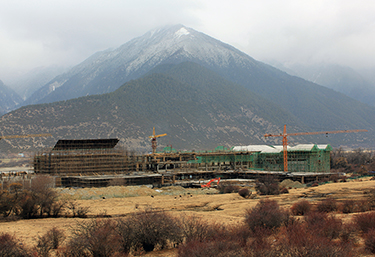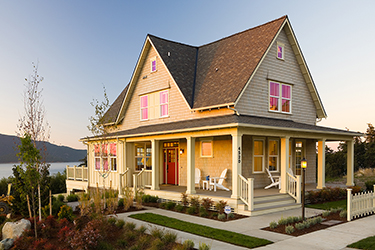|
Subscribe / Renew |
|
|
Contact Us |
|
| ► Subscribe to our Free Weekly Newsletter | |
| home | Welcome, sign in or click here to subscribe. | login |
Architecture & Engineering
| |
April 30, 2014
A lesson learned in 1990s crisis (diversify) helped GCH in recession
Journal Staff Reporter
Murray Hutchins, Jerry Coburn and Peter Geyer are landscape architects and planners who started working together in the 1980s designing resorts in Honolulu.
They moved the firm to Seattle in 1997 and today are partners in GCH Planning & Landscape Architecture. The Seattle firm works in 32 countries and across the U.S., with a focus on the Pacific Northwest.
GCH does public and private work — from urban infill to expansive regional projects. The mix includes resorts, residential communities, hotels, golf courses, urban design, apartments, churches, offices, tribal work and private homes.
They said development is on the upswing in many areas of the world, although global events can quickly alter the pace of development.
Locally, the firm recently finished a streetscape and greenway study of the Roosevelt neighborhood for the city of Seattle, and is working on several communities, resorts and mixed-use projects across the state.



The DJC asked GCH about the market. Here is what the partners had to say.
Where are you getting the most work?
Our work is divided between domestic and international. We are focused on the Pacific Northwest and enjoy the opportunity to improve and bring fresh ideas to the community where we live. Internationally, we work throughout China, from large cities to very remote regions. India is another important hub where we have numerous projects under way. We are also focusing on Vietnam, South Korea, Malaysia, Australia, New Zealand, Saudi Arabia and Morocco.
Tell us about some of your foreign projects.
GCH is the landscape architect and planner for a destination hotel in Tibet at the foot of the Himalaya Mountains. The setting is stunning and the development quite remarkable in its remoteness to literally any urban core or support services.
Beyond the beauty of the surroundings, design for this project was largely based around the existence of a rare and sensitive Yellow Peony plant growing on site.
About 3,000 of these plants are known to grow in the world, with 1,000 on the property. Great care has been taken to preserve this sensitive environmental treasure through design and construction. A research and educational facility will eventually be created on the property with the intention of expanding the species.
Our group is also the landscape architect for the Australian Golf Club in Sydney — the oldest golf club in that country. In collaboration with Nicklaus Design, we are renovating this property for the 2014 Australian Open to be hosted there later this year.
How do you manage foreign projects from here?
We have always managed projects from a single base in order to control design quality, and we travel a great deal as a result. We have in-house staff with language skills for many of the locations where we work and some individuals located permanently in those regions to help coordinate work.
Any tips for firms on breaking into foreign markets?
Patience is probably the biggest lesson we have learned. Every region has its own way of doing things and it can become very frustrating when cultural, technical and quality control related processes differ so widely — especially when time is of the essence, which is nearly always the case. Being present is everything, and a reasonable travel or relocation budget is also important.
How did you get into resorts and golf courses?
Being in Hawaii in our early years we were exposed to a great deal of tourism and resort work. Hotels and recreation projects were a natural part of this work. Each of the firm's partners played key roles in a number of these world class resorts.
The Four Seasons Hualalai and Mauna Lani on the Big Island; Wailea and the Westin on Maui; Manele Bay and Koele on the island of Lanai all come to mind. Elsewhere in the South Pacific and Southeast Asia, the Bora Bora Lagoon Resort in Tahiti, The Nusa Dua Resort in Bali, Sheraton Denarau in Fiji and the Sheraton Haikou in Hainan, China, are others.
What resorts are you doing now?
Currently we are working on two very aggressive multi-season resorts in China: Beishan Village and Changbaishan Resort. When completed, these extensive properties will rival the likes of Whistler Village.
Tell us about some local projects.
They range from large scale master planning to more specific site planning and landscape architectural projects.
There are a number of resort and residential communities we are working on including The Lookout, a lakeside village in Chelan; Ludlow Cove II at Port Ludlow Resort; Trailside in Cle Elum; and ongoing work at San Juan Passage in Anacortes. We have also been busy with the Tehaleh team and their 4,000-acre community in Pierce County. Current hospitality projects include Rosario Resort & Spa's exciting renewal under way on Orcas Island, Clearwater Casino Resort's new hotel addition and urban design for the new Hotel Clare and the existing Westin hotel in downtown Seattle.
How was the recession for you?
Remarkably our company had minimal effects through the recession. Project work and revenues were down, but no layoffs or downsizing.
Foreign work buffered us during this period, though such results may not always be possible as world economies become more dependent on one another.
Interestingly, when the Asian financial crisis struck in the late 1990s we had more work in Asia than the U.S., and we were hit quite hard. Ironically this was a time when most U.S. firms were prospering. Working through that period prompted us to diversify into other regions.
How do you get business?
We have never done much marketing. We have tried to ensure that our built projects sell themselves and, like any company, we concentrate on developing enduring relationships.
What are your growth projections for 2014?
Our business has been growing recently and 2014 has the beginnings of a good year. Having been part of a larger corporation in the past and understanding the struggles a large organization faces, we have tried not to focus too much on growth. As designers our attention is more focused on doing what we love to do, designing and getting projects built.
Lynn Porter can be
reached by email or by phone
at (206) 622-8272.




